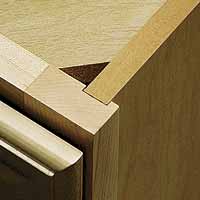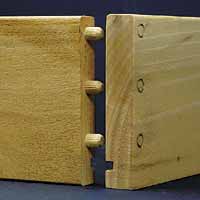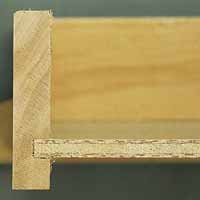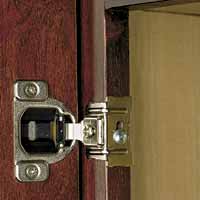| SUBSCRIBE |
| FREE Preview Issue |
| Give A Gift |
| Renew |
| Magazine Customer Service |
| Resources |
| Contact Us |
 |
| Home | Online Preview |
Current Issue |
Builders Plans |
Online Extras |
Videos |
| Issue #246 - April 1998 |
| Selecting
Kitchen Cabinets If you think about it, buying kitchen cabinets has a lot in common with shopping for a new car or truck. Once you overcome the sticker shock, you soon realize there's a huge difference in price and convenience between the stripped-down models and those with all the options. And whether you're talking cabinets or cars, the base model will do the job, even though it lacks the fancy trim and the doors don't shut with that solid sounding thud. While a banker actually set the budget for Workbench's contributing editor Bob Settich's kitchen remodeling project, most home lenders and remodelers suggest limiting a kitchen redo to 15% of the home's value. Since I offered to help him with the installation work and he wasn't replacing many appliances, Bob figured he could spend up to 70% of his budget on the cabinets. Imposing a spending limit means you have to do your homework and be willing to shop around for a dealer who can put together the best package. Before buying new cabinets, Bob and his wife pored over the glossy brochures to get acquainted with product lines and various options. Next, they made a checklist of both needs and wants, and I helped them make a detailed drawing of the kitchen space (see Installing Cabinetry). Then we all set out to buy the cabinets. Stock or Custom You can purchase stock cabinets off a home center's showroom floor, or order custom cabinets with exactly the features you want. With stock cabinets, we found a reasonable selection of woods, styles, and finishes. Most manufacturers offer stock cabinet lines in traditional (face frame) and frameless construction, but carry only the most commonly used sizes and drawer and door configurations. This standardization and limited selection means stock cabinets cost less and are readily available. It also means that if you have an odd-size space in your kitchen, you'll need to order filler strips to close in the gaps. Custom cabinets, as the name implies, are built to fit your particular kitchen space. Because cabinet widths vary, you won't find filler strips (and wasted space) in a custom installation. You also have a wider selection of woods, styles, finishes, and options, but these features boost the overall cost. Some manufacturers offer semi-custom cabinets that give you the best of both worlds. These units are standardized, but come in a wider range of sizes, materials, and styles than stock cabinets. This gives a kitchen designer greater flexibility to work within the given space and your budget. Most home centers and cabinet distributors have dedicated designers and computerized planning software that lets them create different options with a few clicks of the mouse. We even saw one program that gave us a three-dimensional color view of what the new kitchen would look like. Programs like these help tally up the costs so you can see how far you've strayed from budget reality. Cabinet Anatomy While custom cabinet sizes may vary, cabinets are generally built to standardized heights and depths. Upper cabinets are 12"-deep and range in width from 9" to 48" (in 3" increments). Standard height is 30", but you can install 36"- or 42"-tall cabinets to gain extra storage if your kitchen ceiling height permits the taller units. Base cabinets are typically 24"-deep and 34-1/2"-high, so a 1-1/2"-thick countertop brings the final counter height to 36" -- an industry standard for cabinets and appliances. Base cabinet widths generally mirror the width of the upper cabinets above them (9" to 48") and can include all drawers or a door and drawer configuration. Visual proportions dictate that door width never exceeds door height, so wider cabinet units will always have two or more doors. If you want extra counter or storage space, you can get 30"-deep base cabinets, but use 15"-deep upper cabinets to keep everything proportionally appealing. Tall utility cabinets, often used as pantries or broom closets, are available in 84", 90", and 96" heights, and come in standard wall or base cabinet depths. These standard dimensions apply to both framed and frameless-style cabinets. Traditional framed cabinets have a face frame that provides a great deal of structural support to the cabinet. Door hinges mount to the frame and doors and drawer fronts typically overlay the frame. Frameless (European-style) cabinets are basically open boxes usually built from 5/8"-thick melamine-covered particleboard. Since this style lacks a face frame, the door hinges mount directly to the cabinet sides to give wide-open access to the interior space. Because they lack the face frame, the boxes get their structural strength from the thicker material used in the sides, back, and bottom, which typically are joined with glued dowels. Where Quality Counts At a glance, it's sometimes hard to tell quality cabinetry from economy versions, since many of the features wind up hidden from view once the cabinets are installed. To get a better idea of the differences, I compared a high-end base cabinet with a similar economy model, and was surprised by what I found. The economy version had 3/8"-thick vinyl-coated particleboard for the cabinet sides and bottom, and 1/8"-thick fiberboard for the back. The cases were held together with stapled butt joints. The high-end model had 3/4"-thick veneered MDF sides and the case was built with glued tongue-and-groove joints. It also had wood corner bracing glued into place (Figure 1). (The economy model had plastic braces that were stapled in). While both cabinet units had solid wood face frames, I found the high-end model had two dowels in each joint. The economy model came with stub tenon-and-mortise joints that were glued and stapled. The drawers on the high-end cabinet had 1/2"-thick solid wood sides, fronts, and backs (although you could even upgrade to 3/4"), that were assembled with dowel joinery (Figure 2), an inset plywood bottom (Figure 3), and an adjustable drawer front. The unit's heavy-duty drawer glides gave the drawers a smooth, solid feel when opening or closing them. The manufacturer used these same glides on the cabinet's pull-out shelves. The economy model's drawer was stapled together from 1/2"-thick vinyl-coated particleboard and it wobbled in the glides when I pulled it out. The drawer also rattled when I closed it, compared to the solid thud of the other model. When I compared the doors, I found similar differences in materials and construction. The makers of the high-end model used solid wood for frame-and-panel doors, while the economy model came with a veneered panel. The more expensive unit also featured adjustable, concealed hinges that let you precisely align the doors (Figure 4). While self-closing, the economy model's hinges weren't adjustable. |
|
|
||||
|
|
||||
Warranties
also gave an indication of quality. The high-end model carried a
seven-year warranty on materials and workmanship and a lifetime
warranty on hinges and drawer glides. The other model had a one-year
limited warranty. |
| ©
August Home Publishing Company Magazine Customer Service - Privacy Policy - Terms of Use - Contact Us |




